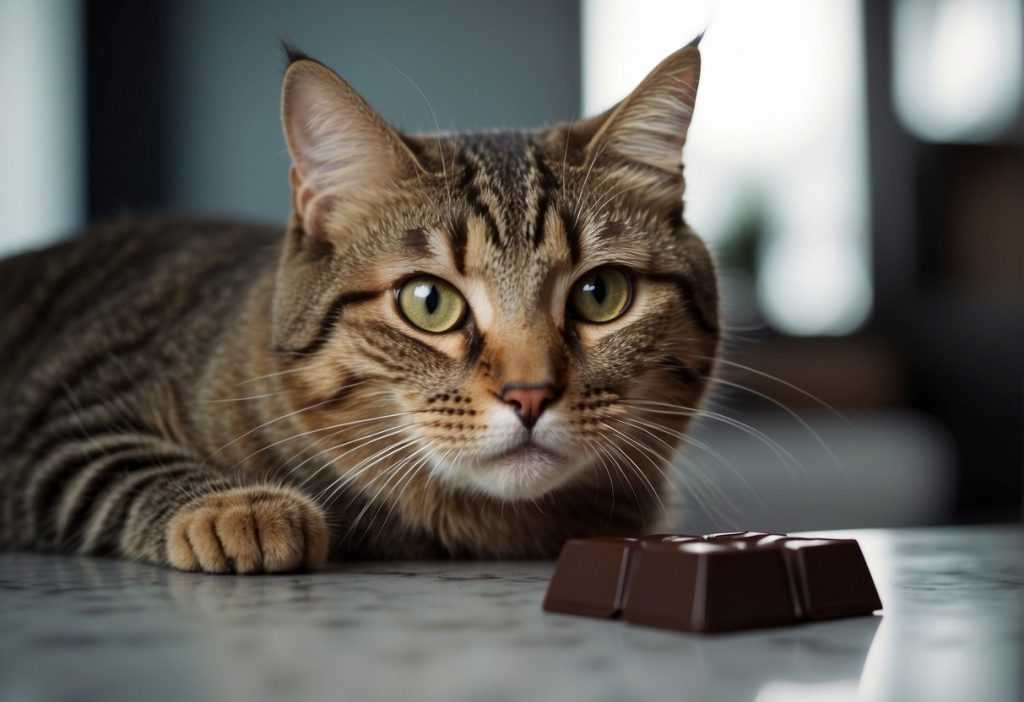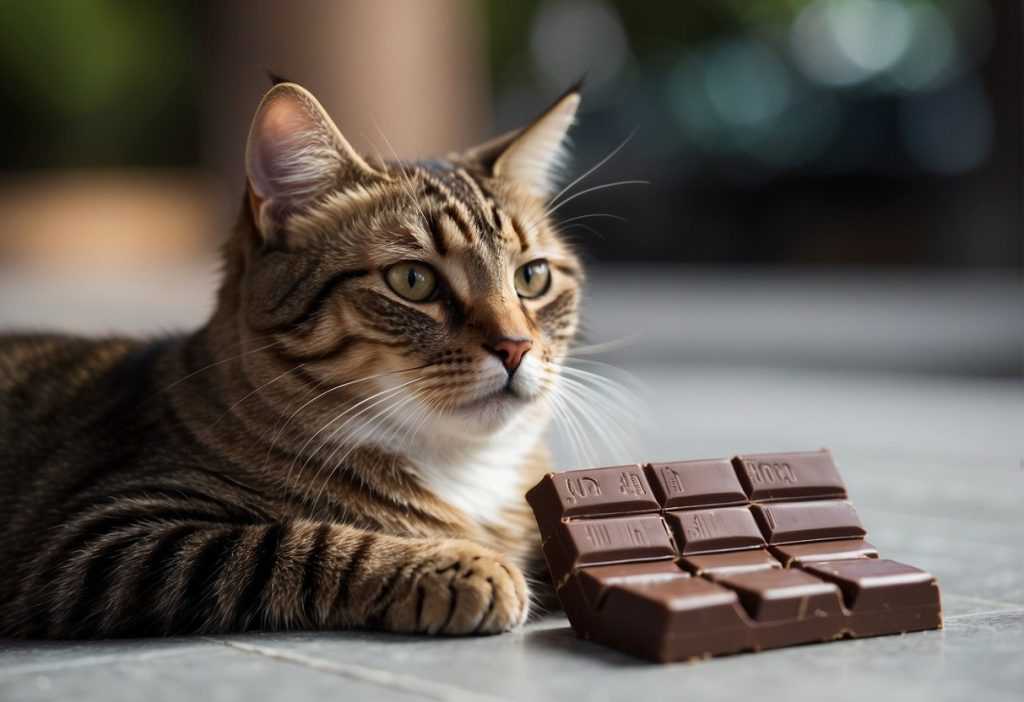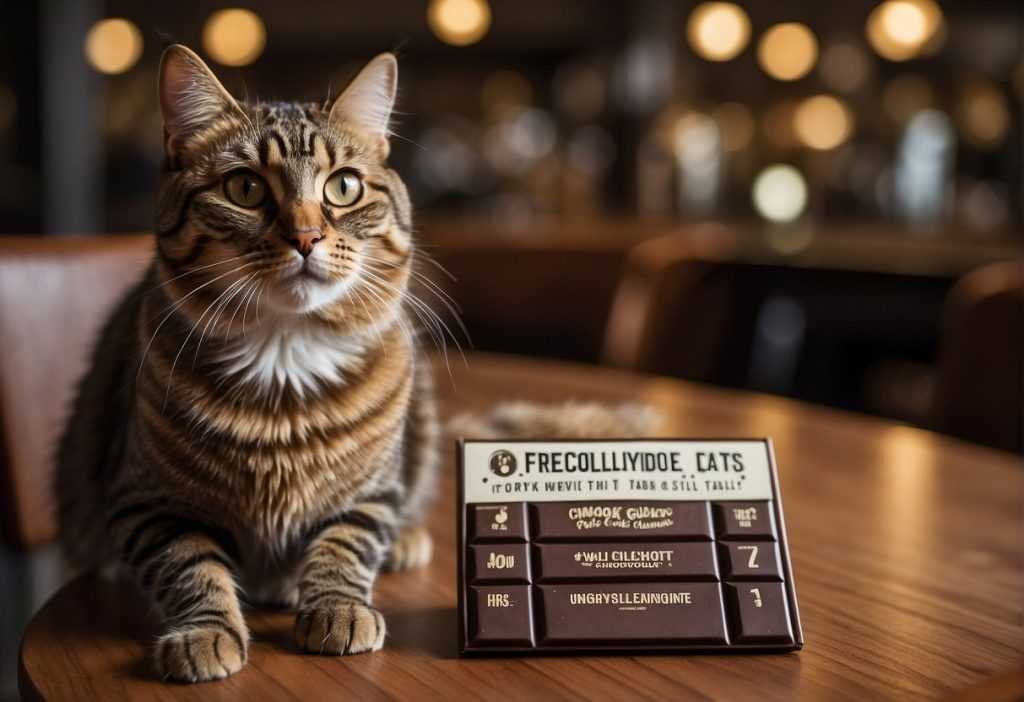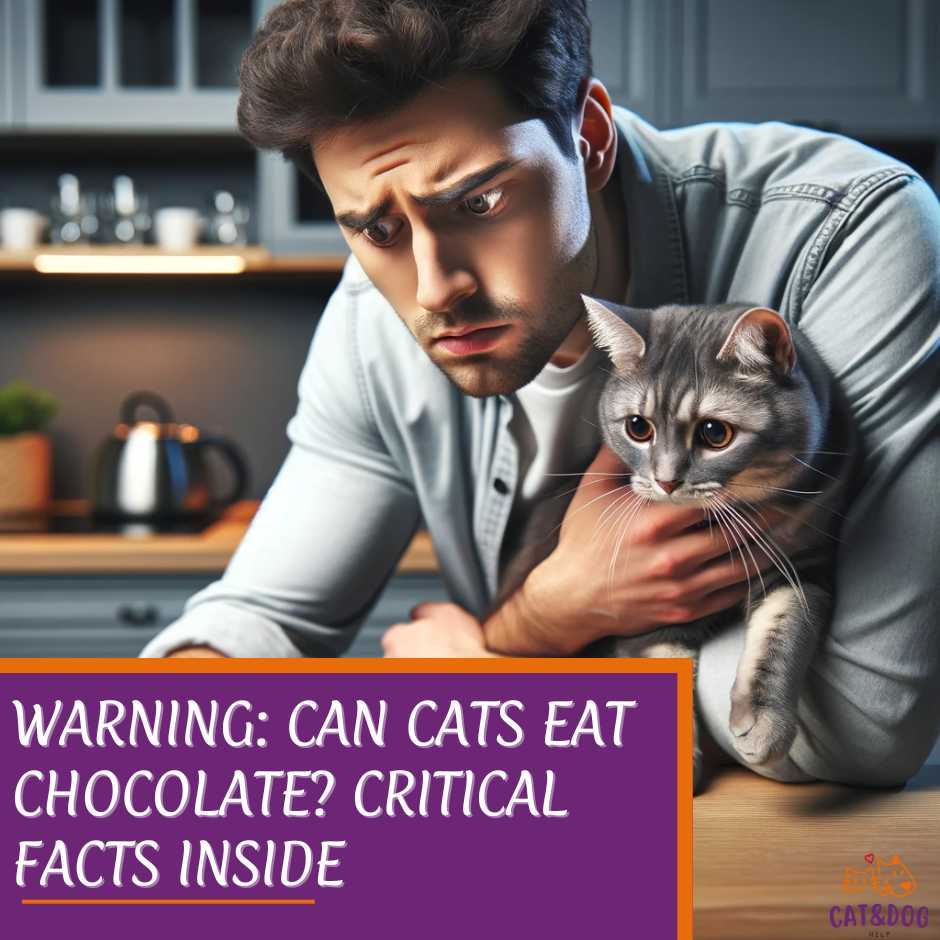When it comes to the sweet treats in our lives, most of us know that certain foods, while delicious for humans, can be dangerous for our pets.
So, Can cats eat chocolate?
You might wonder if the same rules apply to your feline friends, especially when it comes to chocolate. The straightforward answer is no, cats cannot safely eat chocolate.
Why? Well, chocolate contains substances called theobromine and caffeine, both of which are toxic to cats—even in small quantities.

Understanding why chocolate is harmful to cats is critical for any pet owner. While our furry companions may seem curious about our snacks, chocolate should never be shared with them.
Not only is their inability to taste sweetness a saving grace in this scenario, but the physical consequences of indulging could be severe. Recognizing the signs of chocolate poisoning is imperative.
Symptoms can range from vomiting to more serious conditions like seizures, and in some cases, it could be fatal.
In a world full of nibbles and noshes, it’s essential for cat owners to be aware of what is and isn’t safe for their pets.
Although accidental ingestion might be rare, it’s crucial to take precautions to ensure chocolate is kept well out of reach of curious paws.
You can also pay attention to foods that contain chocolate such as cakes, bread, chocolate candy, vanilla yogurt and other sweet foods which are likely to be dangerous for your cat.
Key Takeaways
- Cats should never eat chocolate due to toxic ingredients like theobromine and caffeine, so avoid any harmful food to cats..
- Knowing the symptoms of chocolate poisoning helps in seeking timely veterinary care.
- Prevention is key; always keep chocolate inaccessible to your feline companions.
Can Cats Eat Chocolate? Expert Advice Inside
Ever wonder why something so delicious to you can be dangerous to your furry friend? It’s all about the chemistry inside that chocolate bar.
Chocolate contains two main toxic components to cats: theobromine and caffeine. (1)
The Toxic Ingredients in Chocolate
Cats and chocolate don’t mix. Theobromine, the prime culprit here, belongs to the same family as caffeine. Both of these are stimulants, and your feline’s body just can’t handle them the way yours can. (2)
Here’s a touch of number crunching to put it into perspective:
- Theobromine: Predominantly found in cocoa, its concentration varies in different chocolate types:
- Dry cocoa powder (most theobromine)
- Baking chocolate
- Dark chocolate
- Milk chocolate (less theobromine)
- White chocolate (minimal theobromine, but still not safe)
While chocolate must be avoided due to its toxic components, cat owners can explore a variety of feline-friendly treats that are both safe and enjoyable for their pets, ensuring they can indulge their furry friends without risk.
How Chocolate Affects a Cat’s Body
Did you know cats process these stimulants much slower than we do? Theobromine can stay in their system for a dangerously long time.
What might give you a bit of a buzz can wreak havoc in their tiny bodies, causing:
- Restlessness
- Rapid heart rate
- Tremors
Tragic tales of chocolate poisoning in cats pop up too often. Vets share stories about whiskered patients who sneak a bite and end up with severe symptoms. (3)
Does a tiny amount matter? It does. Even a small piece of chocolate can lead to big problems. It’s just not worth the risk.
Keep in mind, your cat’s curiosity isn’t worth a medical emergency. Stick to cat-safe treats and keep the chocolate stash securely out of paw’s reach.
Remember, their nine lives are precious, and so is chocolate – just not together!
Recognizing Chocolate Poisoning in Cats
Hey there cat parents! Let’s talk about something serious – chocolate and your feline friends. As tempting as it is to share a bite of your snack with your kitty, chocolate is a no-go.
But what if your cat accidentally nibbles on some? Let’s dive into the signs of chocolate toxicity, so you’re ready to act fast.
Symptoms of Chocolate Toxicity
When your cat ingests chocolate, here’s a checklist of symptoms they may exhibit:
- Vomiting: It’s one of the body’s first reactions to get rid of the toxin. (4)
- Diarrhea: Keep an eye on their litter box for any unusual activity. (5)
- Rapid breathing: If they’re panting or breathing faster than usual, take note. (6)
- Elevated heart rate: This might be tougher to notice, but it’s a significant concern.
Timeline of Symptoms
Symptoms typically kick in within 4 to 6 hours after eating chocolate and can linger up to 3 days. The longer the symptoms last, the more critical the situation.
What to Do If Your Cat Eats Chocolate
Follow these steps if you suspect your cat’s had a chocolate treat:
- Stay calm: You’ve got this.
- Assess the amount: How much chocolate did they eat? What type? This info is crucial.
- Call your vet: Promptly reach out for professional advice.
Don’t have your vet’s number handy? Contact a veterinary poison control center:
- ASPCA Poison Control: (888) 426-4435
- Pet Poison Helpline: (855) 764-7661
Keep these numbers somewhere accessible. Having a plan can make all the difference!
Practical Tips for Cat Owners

Have you ever caught your cat eyeing that chocolate bar on the counter? We all know that chocolate and cats don’t mix, but life gets busy, and sometimes things slip. So, how can you keep your sneaky feline safe?
Preventing Accidental Chocolate Ingestion
Safe Storage:
- Keep chocolate in closed cabinets or high shelves.
- Consider child-proof locks for curious kitties.
Pet-Proofing:
- Check for stray pieces that may fall unnoticed.
- Trash cans with lids are a must – cats might scavenge when you’re not looking!
A tale from the trenches: Ever heard of a cat that opened a drawer? It happens! Secure your sweets in a “cat-proof” area like a locked pantry.
Safe Alternatives to Chocolate for Cats
Wondering what treats can make your cat’s day without the risks of chocolate? Here’s a list of cat-safe treats:
- Store-bought cat treats: Crunchy, soft, or freeze-dried
- Cooked meat: Small pieces of chicken or turkey
- Catnip: A classic for a reason!
For the DIY fans, whip up a homemade cat delight with vet-approved recipes like tuna cookies. Just mix canned tuna, catnip, and a bit of flour or eggs, and bake it for a few minutes.
Always introduce new treats gradually to make sure your cat’s stomach agrees with your culinary experiments.
Remember, while chocolates are a no-go, showing love to your purring pals can come in many safe and delicious forms!
Keep those treats cat-friendly, and those tails will keep wagging. Or at least, as close to wagging as a cat’s tail gets!
In-Depth Focus on Chocolate Toxicity
Have you ever wondered, as you indulge in a square of dark chocolate, whether your feline friend can join in? The answer, even if met with a pleading meow, is a definite no.
Here’s the scoop on why chocolate and cats are a bad mix.
What’s the big deal with chocolate?
Chocolate contains substances called theobromine and caffeine, which are perfectly fine for us humans in moderate amounts, but a no-go for your kitty. (7)
- Theobromine: This is the main culprit when it comes to chocolate toxicity in cats. It’s a stimulant that can cause adverse effects on the central nervous system and heart.
- Caffeine: Much like in humans, caffeine can lead to increased alertness. In cats, it can cause jitteriness and even heart palpitations. (8)
Just how much is too much? It’s not just about how much, but what kind:
- Dark chocolate and baking chocolate pack a lot more theobromine than milk chocolate.
- A mere ounce of dark chocolate can be severe, even life-threatening, for your cat.
Symptoms to watch out for: Pay attention to these signs that can occur if your cat nibbles on chocolate:
- Vomiting or diarrhea
- Rapid breathing
- Increased heart rate
- Seizures
Remember, each cat is unique, and ‘safe’ amounts are hard to predict; thus, it’s best to err on the side of caution and keep chocolate out of paw’s reach.
Expert Insights and Resources Seeking Knowledge? Interviews with veterinarians highlight that feline nutrition significantly differs from ours, showing why chocolate is off-limits.
As for the technical details, scientific studies on chocolate toxicity in cats outline specifics. Engage with in-depth articles and vet publications to broaden your understanding.
Caught in a pinch? If you suspect your cat has had chocolate, acting fast can make all the difference. Keep that vet number handy, just in case!
Quick Recap

Have you ever caught your feline friend eyeing a piece of chocolate?
Well, here’s the straight scoop: Chocolate is a big no-no for cats. Why, you ask? It all comes down to two troublemakers within chocolate: theobromine and caffeine.
Key Takeaways:
- Chocolate is toxic to cats. Keep it out of paws’ reach!
- Theobromine and caffeine can harm your cat’s nervous and cardiac systems.
- Cats cannot metabolize theobromine as humans can, making it more dangerous.
Here’s a quick breakdown of the facts:
| Compound | Danger Level to Cats |
| Theobromine | High |
| Caffeine | High |
Remember:
- Even a small amount of chocolate can be harmful. No sharing your sweets!
- If you suspect your cat has snuck a bite, call your vet right away.
While learning what keeps your kitty tickin’ is a never-ending journey, making sure they steer clear of chocolate is a great step in keeping them healthy and happy.
Always be aware of what your furry friend is nibbling on – their safety might just depend on it. Keep up the great work, and pat yourself on the back for being such a awesome pet parent!
By staying informed and vigilant, you’re on the right track to preventing a not-so-sweet situation. Ready to learn more about pet safety? Your curiosity could be a lifesaver!
Frequently Asked Questions

Isn’t it curious how such a delightful treat to us can be dangerous to our feline friends? Here’s a quick dive into the what, why, and how of cats and chocolate.
Is it safe to give my cat any form of chocolate?
Not! Chocolate contains substances like caffeine and theobromine, which are very toxic to cats. No matter how small the amount, it’s a firm no-go.
What should I do if my cat has consumed chocolate unwittingly?
Time is of the essence—reach out to your vet immediately. Quick action can be crucial for your cat’s health.
Why is chocolate harmful to cats, and what are the symptoms of toxicity?
Caffeine and theobromine found in chocolate can cause serious health issues in cats, such as muscle rigidity, low blood pressure, and rapid breathing. Keep an eye out for increased thirst, vomiting, or diarrhea.
In case of accidental chocolate ingestion, how long does it take for symptoms to appear in cats?
Symptoms can manifest as soon as 6 to 12 hours after ingestion. It’s important to monitor your cat closely during this time if you suspect they’ve eaten chocolate.
Are symptoms of chocolate poisoning in cats immediate?
Not necessarily immediate, but don’t wait to see. If you think your cat has had chocolate, contact your vet right away, as early intervention could prevent more severe symptoms and health implications.
Can a small amount of chocolate ever be safe for cats?
No, no amount of chocolate is safe for cats. Always keep chocolate out of reach, and stick to cat-friendly treats instead. Your cat will thank you with purrs and cuddles!


